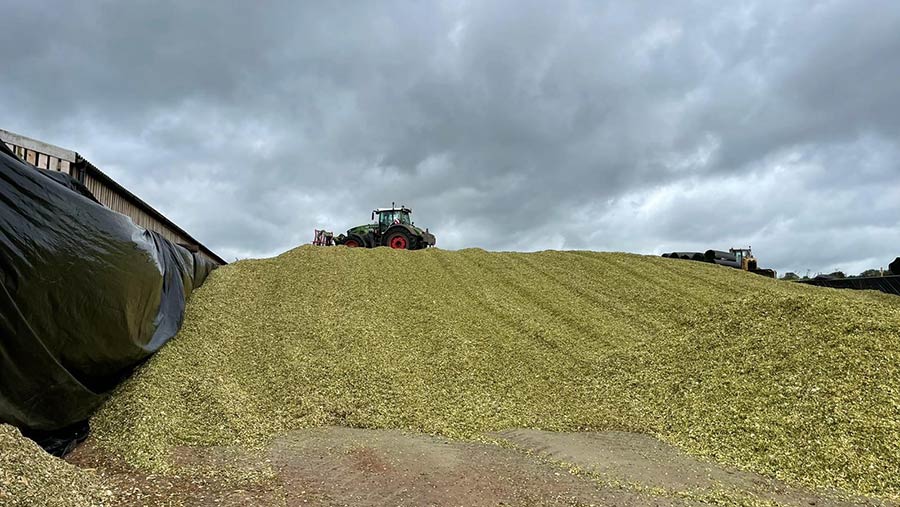Maize Watch: Drill straight after harvest to protect soil
 Chris Blake's clamp © Neil Groom
Chris Blake's clamp © Neil Groom Growers are advised to drill or cultivate maize fields immediately following harvest, before rain creates sticky conditions.
Pulling a tine through to the depth of any compaction from the trailers will also ensure that rain soaks into the soil, rather than running off down any slope, causing soil and nutrient loss, says Grainseed manager Neil Groom.
“Drilling winter wheat or sowing Westerwolds or Italian ryegrass should always be undertaken to benefit the soil. It is simple and cheap to do,” he says.
Chris Blake, who is taking the samples for Farmers Weekly on his farm in Crediton, Devon, agrees: “We select early-maturing maize varieties to enable us to return the maize fields close to home back to the grazing platform. In our mild climate, we can do this as long as the maize is harvested in September,” he says.
On rented fields further away, Chris will sow Italian ryegrass or Westerwolds if the field is not going back to the landlord for corn.
This is then grazed by youngstock at the end of February and throughout spring, before the fields are prepared for maize again.
“We have built new clamps for the maize this year, which are more accessible for the trailers and much wider, so that we can get two buck rakes rolling the silage in.
“Steve, our contractor, has a great team and the trailers are not long in refilling. This means we need to get the maize clamped efficiently and rolled down tight, since it’s the energy driver of our winter ration,” says Chris.
Harvest progress around the UK
Neil reports that maize dry matters this week have continued to increase rapidly.
This means keeping a good eye on crops to check grain maturity and leaf dry down twice a week.
“Liaise closely with your contractor so you are scheduled in for when your crop is fit to harvest,” he says.
Progress of maize crops on six sites in England, Scotland and Wales |
||||
| Site | Drill date | Height above sea level (m) | Crop dry matter (19 September) |
Increase from last week |
| Petworth, West Sussex | 7 May | 50 | Harvested | NA |
| Harleston, Norfolk | 18 May | 30 | 29.3% | +4.7 |
| Crediton, Devon | 22 April | 118 | 35.1% | +2.0 |
| Ticknall, Derbyshire | 8 May | 67 | 31.2% | +4.3 |
| Narbeth, South Wales | 4 May | 32 | 32.2% | +5.0 |
| SRUC, Dumfries, Scotland (Samco film) | 24 April | 45 | 30.1% | +4.3 |
| SRUC, Dumfries, Scotland (conventional) | 10 May | 45 | 27.6% | +3.2 |
| Variety: Faith. Variety under film: Palladium | ||||
How to keep roads clean and safe at maize harvest
Autumn rainfall in all areas of the country puts the focus on road safety during maize harvesting, particularly after heavy downpours, says Grainseed’s Neil Groom.
“In some areas of the South West last week, there was torrential rain due to changes in the position of the jet stream, but all areas of the country have seen significant rainfall,” he says.
Maize standing in the field protects soil from damage and, on free-draining soils, crops could be ready for harvesting 24 hours after the rain stops.
However, Neil says the amount of soil that will be attached to tractors and trailers will have increased. “This presents danger to other road users,” he warns.
“It is therefore important to think about the route that trailers take back to the clamp. If they are able to use farm tracks or the edges of grass fields, they will clean up before travelling on public roads.”
Road sweeping
Neil suggests that if using public roads is unavoidable – this will be the case for most farms – a road sweeper and good signage will be required to keep roads clean and prevent accidents.
“Start sweeping as soon as you start chopping to keep the road clean from the start,” he says.
“Filling in holes in gateways with hardcore to prevent puddling and cutting back hedges to improve sight lines will also help the harvest team.
“Furthermore, all staff should wear high-vis clothing – and both tractor and trailer lights should be checked every day to ensure good working order is maintained.”
